Austria’s Silent Night: 200 years, 300 languages
One of my early childhood memories surrounding Christmas is learning and singing “Silent Night”. This humble melodic carol is known around the world and sung in over 300 languages and dialects. 2018 is the 200th anniversary of the hymn’s first public performance, and that’s why I’m on a train traveling north from Salzburg to the Austrian town of Oberndorf.
With over 5000 residents, Oberndorf lies opposite the German town of Laufen along the winding flow of the Salzach river. Laufen-Oberndorf was once a single community whose people derived their greatest business and wealth with salt carried on barges from upstream in Hallein and transferred onto larger ships for transport downstream to the Inn river and Passau. After the arrival (and departure) of Napoleon’s French troops, the river became a border, and the town was split in two after over 1000 years as a single community#. Although Oberndorf and Laufen remain in separate countries, the European Schengen treaty has helped reforge their common bonds with the abolishment of border controls.
Short History
Between 1817 and 1819, Joseph Mohr lived and worked in Oberndorf as curate, minister, and schoolteacher for the salt-barger community. The organist for Oberndorf’s St. Nicolas Church was Franz Gruber, a fellow schoolteacher and sexton at a parish in nearby Arnsdorf. Mohr and Gruber tended to spiritual and education needs for their towns, and with their common zeal for music, they quickly became friends. On Christmas Eve 1818, Mohr brought his song to Gruber who added the melody. That very evening after evening mass at Oberndorf’s St. Nicholas Church, Mohr’s completed song, “Stille Nacht, Heilige Nacht” was performed for the first time with Gruber on his guitar as the only accompaniment.
Over years and decades, the song had generally been considered to be Tirolian in origin, but handwritten letters show Joseph Mohr composed the song by 1816 when he lived in Mariapfarr, a town 120 kilometres southeast from Salzburg. The original German-language version of the song has six verses; the English version has three which are translations of verses 1, 6, and 2.
At Oberndorf’s Stille-Nacht-Platz (Silent Night Square), the two key elements are the Stille-Nacht-Kapelle (Silent Night memorial chapel) and the Stille Nacht Museum. The original St. Nicholas church was in bad shape and torn down in 1906. To maintain the memory of the first performance of the Christmas song, construction began in 1928 for a chapel at the same location, and the townspeople celebrated the chapel’s inauguration in 1937. With the museum’s opening in November 2016, exhibits describe the history of how the song came to be, highlight the lives of Mohr and Gruber, explain the context of culture and place of the times in the late-18th to early-19th century, illuminate the importance of the salt trade on the neighbouring Salzach river, and celebrate the song’s longevity and popularity around the world.
Every year, evening mass on Christmas Eve from the Silent Night memorial chapel is broadcast to the world on webcam.
# The 1814-1815 Congress of Vienna enforced the Salzach river as the border and separation between the nation-state of Bavaria (Laufen) on one side and the Austrian Empire (Oberndorf) on the other side.
Oberndorf bei Salzburg
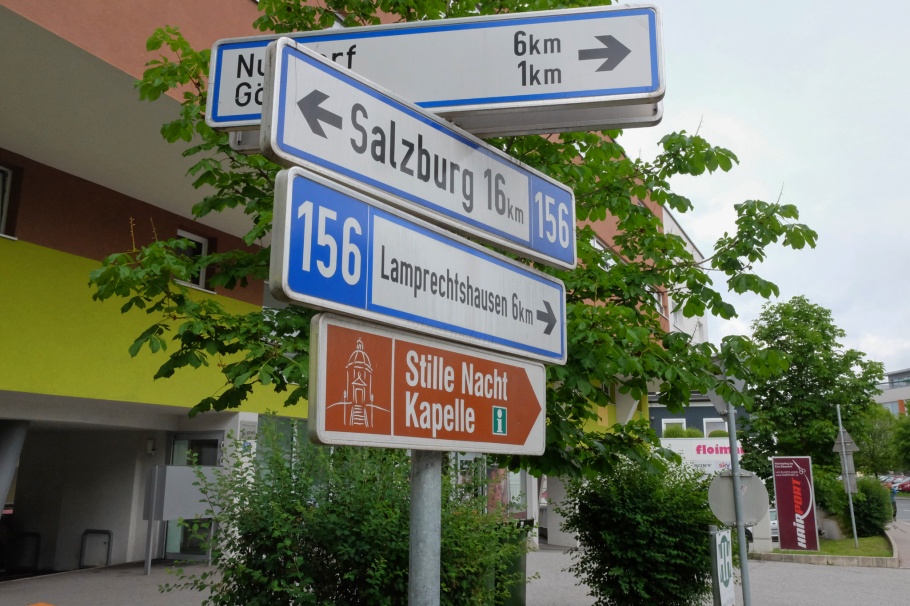
Street sign on Salzburger Strasse.
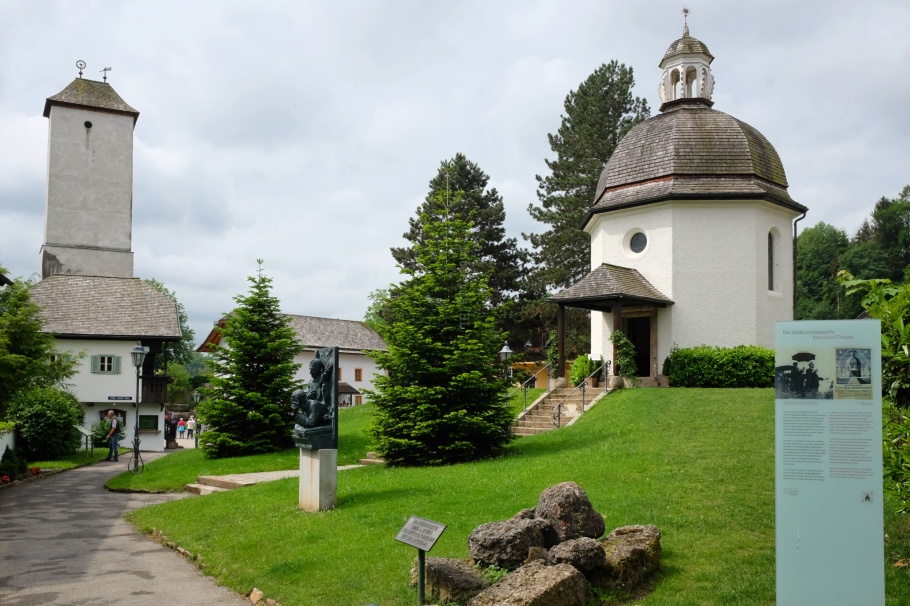
Facing south from Salzburger Strasse, Silent Night square with the memorial chapel at right.
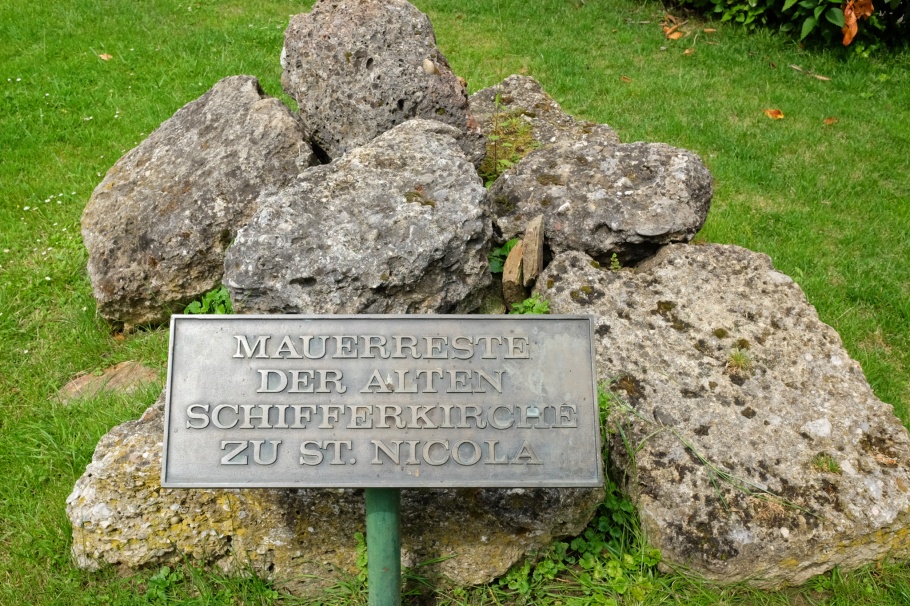
Stone wall remnants (Mauerreste) from the original St. Nicholas church.
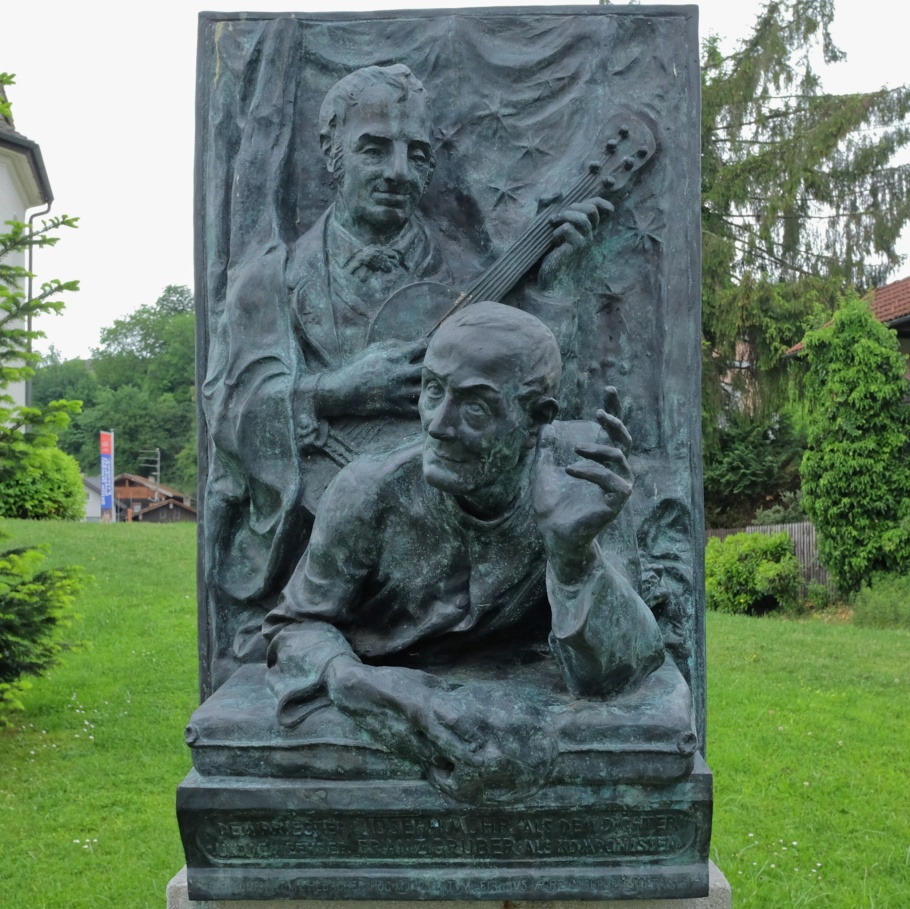
Memorial plaque to Joseph Mohr (lyrics, 1815) and Franz Gruber (melody, 1818).
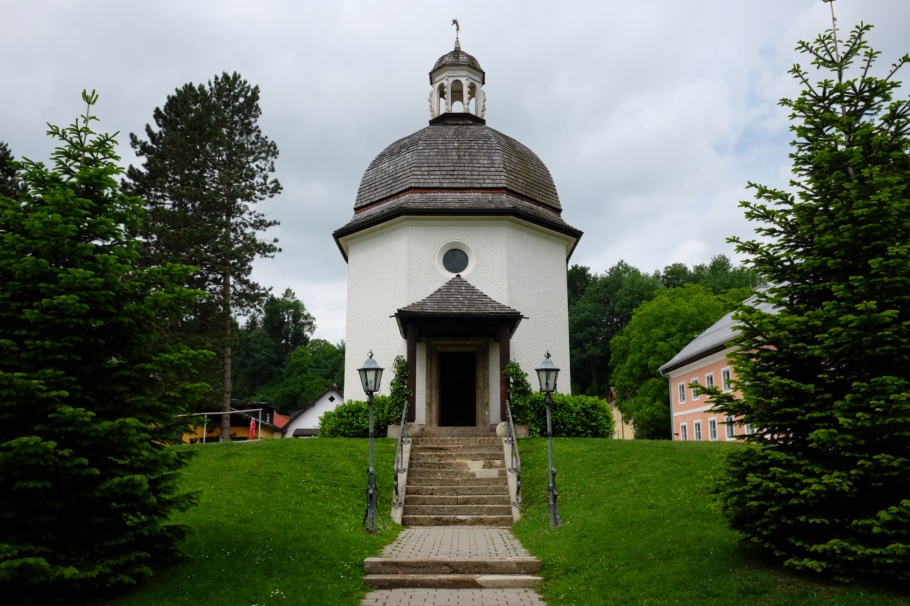
Silent Night memorial chapel, inaugurated 1937.
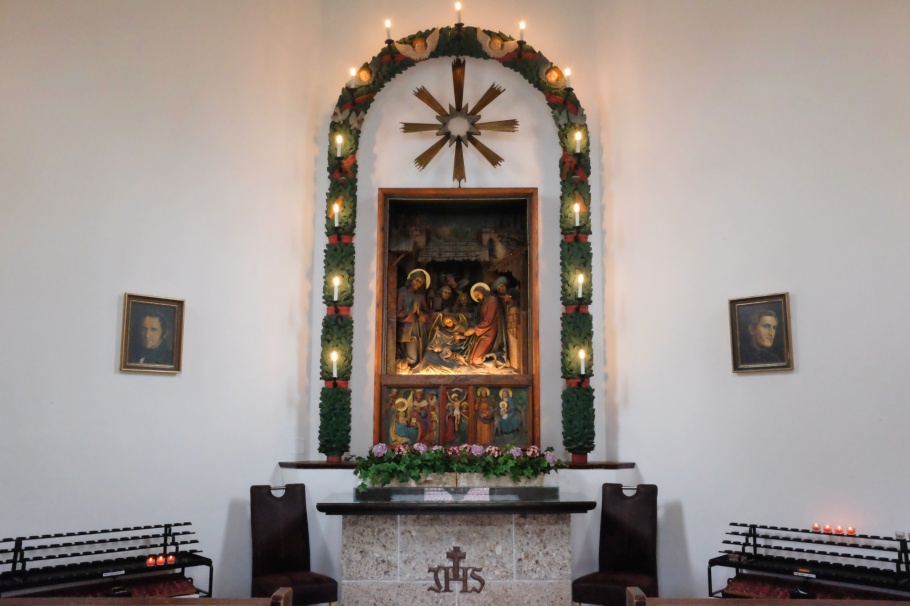
Chapel interior and central altar.

Inside the chapel: stained glass window to Mohr (lyrics).

Inside the chapel: stained glass window to Gruber (melody).
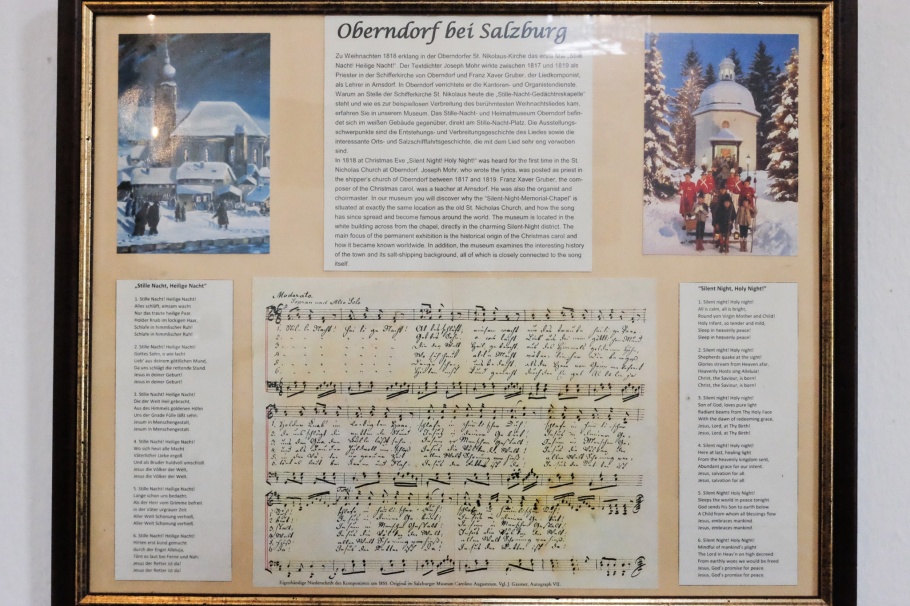
Copy of handwritten song; original manuscript in Salzburg Museum.
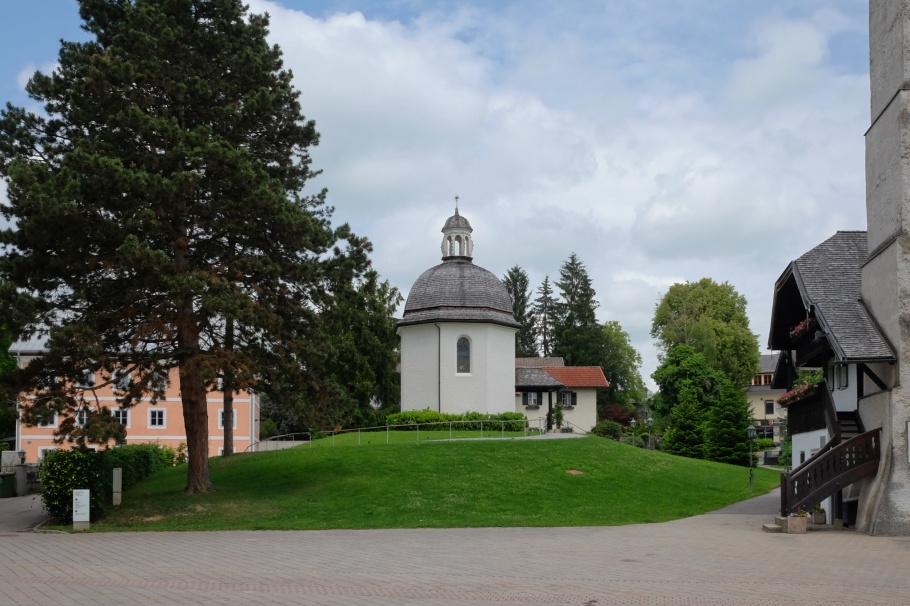
Stille Nacht Platz, facing north: museum at left, chapel at centre.
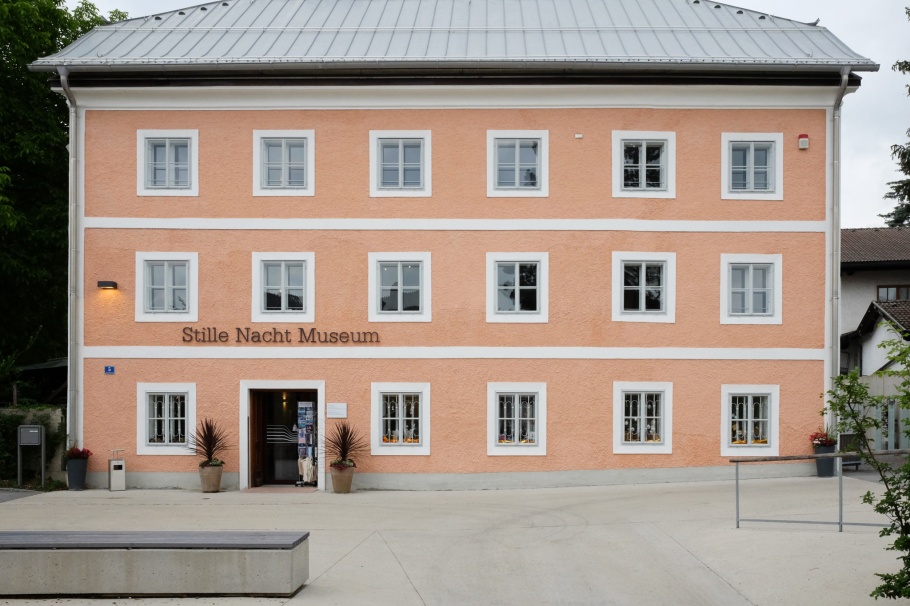
Stille Nacht Museum, opened 2016.
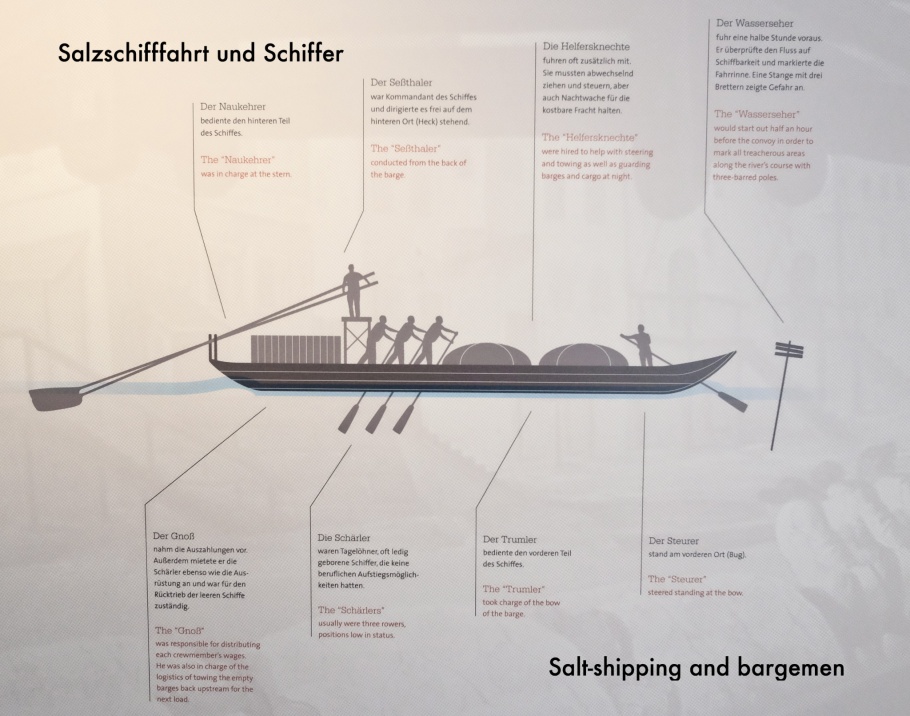
Local economy once driven by salt-mining and salt-transport on river barges.
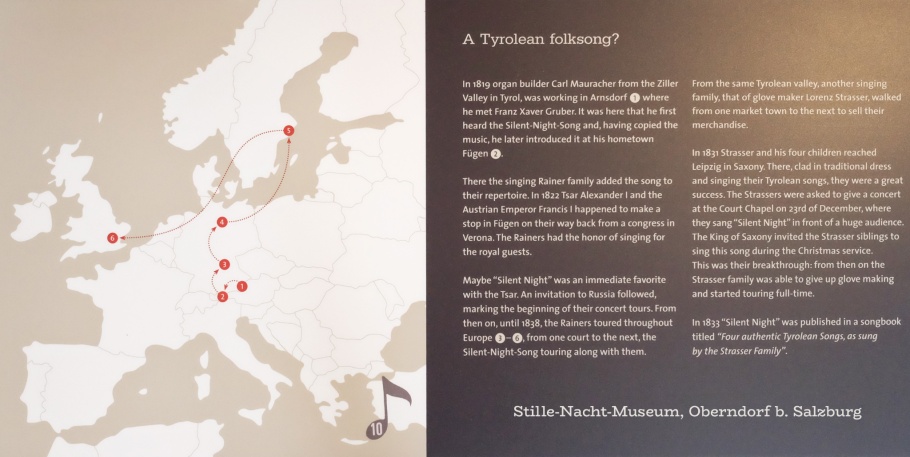
The song wanders through continental Europe and crosses the “ditch” to England.
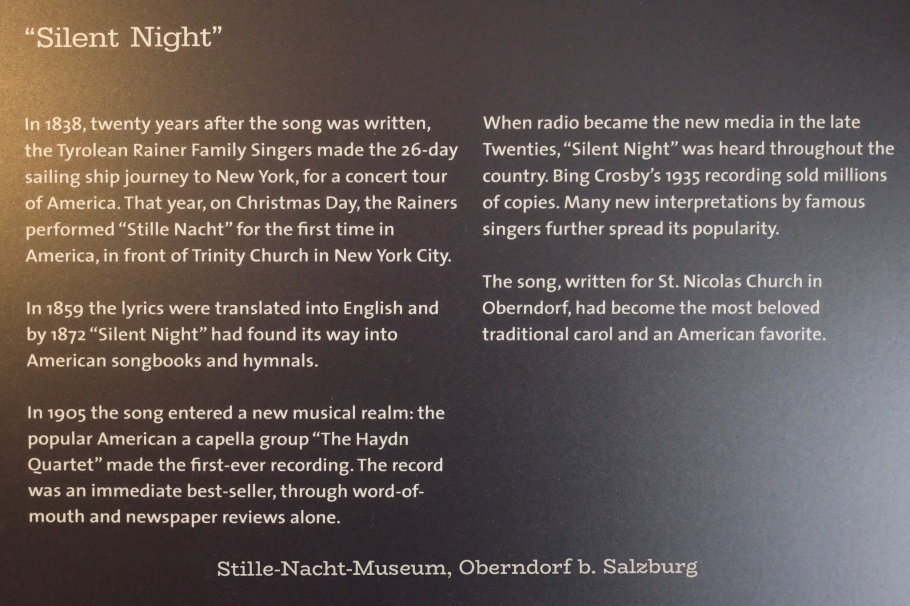
The song arrives in America: 1838 debut in New York.
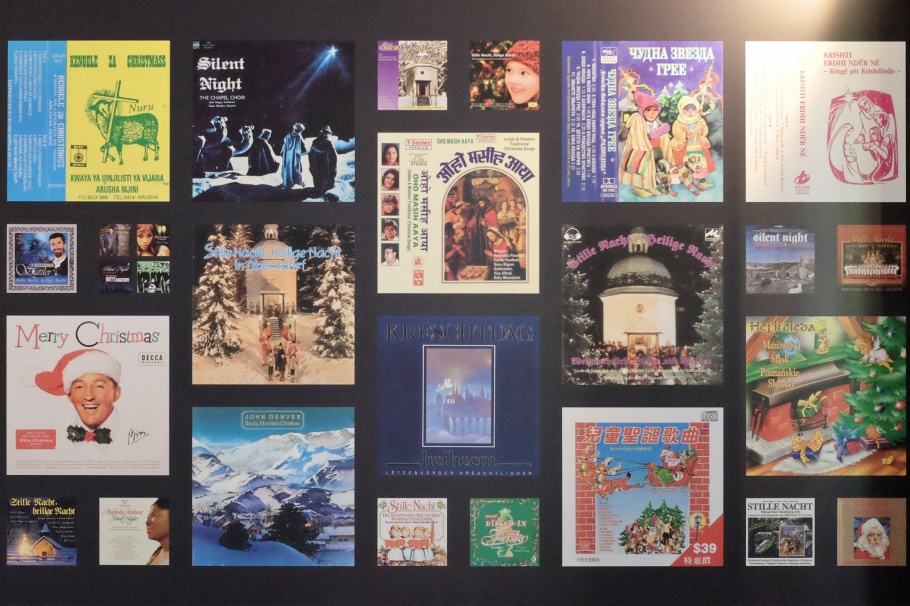
Today, “Silent Night” is available around the world in multiple languages and dialects.
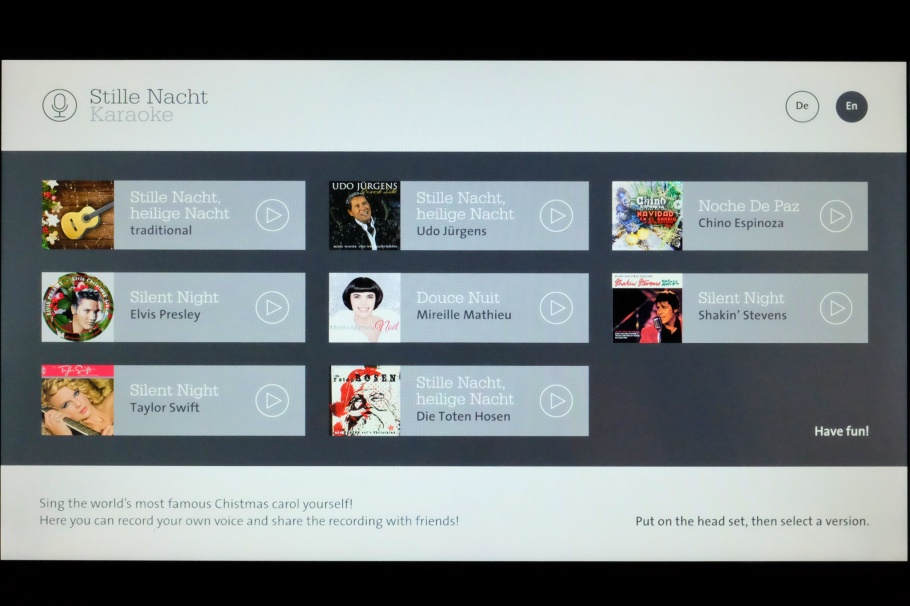
Karaoke sing-along: see/listen below for a glorious punk cover by Die Roten Rosen (The Red Roses), also known as Die Toten Hosen (The Dead Pants).
| Strophe 1. (Verse 1) → |
Strophe 6. (Verse 6) → |
Strophe 2. (Verse 2) |
|---|---|---|
|
Stille Nacht! Heilige Nacht! Alles schläft; einsam wacht Nur das traute hochheilige Paar Holder Knabe im lockigen Haar Schlaf’ in himmlischer Ruh! Schlaf’ in himmlischer Ruh! → |
Stille Nacht! Heilige Nacht! Hirten erst kund gemacht Durch den Engel Alleluja Tönt es laut von fern und nah Christ der Retter ist da! Christ der Retter ist da! → |
Stille Nacht! Heilige Nacht! Gottes Sohn! O wie lacht Lieb’ aus deinem göttlichen Mund Da uns schlägt die rettende Stund’ Christ in deiner Geburt! Christ in deiner Geburt! |
|
Silent night! Holy night! All are sleeping, alone and awake Only the intimate holy pair Lovely boy with curly hair Sleep in heavenly peace! Sleep in heavenly peace! → |
Silent night! Holy night! To shepherds it was first made known By the angel, Alleluia Sounding forth loudly far and near Christ the Savior is here! Christ the Savior is here! → |
Silent night! Holy night! Son of God, O how he laughs Love from your divine mouth Then it hits us – the hour of salvation. Christ at your birth! Christ at your birth! |
More info, in English
• Stille Nacht Museum Oberndorf
• Tourismusverband Oberndorf
• Stille Nacht Association
• Austria Tourism
Hours and Directions
The memorial chapel is open daily including holidays from 830am to 6pm; there is no admission charge. The museum is available to visitors; check this website for (variable/seasonal) hours. Admission for adults is €4.50; check this website for more information.
From Salzburg Hauptbahnhof, S-Bahn S1 trains operate to Oberndorf bei Salzburg every 30 minutes with the journey itself lasting 26 minutes. After disembarking at the train station called “Oberndorf b. Salzburg Bahnhof”, it’s a 10- to 15-minute walk to the northwest to Stille-Nacht-Platz. Alternatively, there’s intermittent service with regional bus 112 or 880, from “Oberndorf Bahnhof” to stop “Oberndorf Altoberndorf”.
Last updated: 15 Dec 2023. I made all photos above on 24 May 2018 with a Fujifilm X70 fixed-lens prime; alle Fotoaufnahmen sind mit Wasserzeichen versehen worden. This post appears on Fotoeins Fotografie at fotoeins.com as https://wp.me/p1BIdT-c8L.
18 Responses to “Austria’s Silent Night: 200 years, 300 languages”
Such a helpful post. My family will be in Salzburg this December and we are planning to book a Silent Night tour. I am even more excited now after reading your post, and so thank you for sharing. – Amor
LikeLiked by 1 person
Hi and you’re very welcome, Amor. Please note there’s a Silent Night Museum in Hallein (south of Salzburg) and a small museum in Arnsdorf (a little north from Oberndorf), and you should plan the correct places you intend to visit.
LikeLiked by 1 person
Thank you so much for the additional info. I’m learning so much about Salzburg from your pictures and stories 🙂
LikeLiked by 1 person
Thank you for your kind comment! If you and your family decide to visit Oberndorf, I think a highlight of your visit would be to sing “Silent Night” karaoke inside the Silent Night Museum: you’ll have a choice of languages for the song. 😊
LikeLiked by 1 person
Thanks Henry for this new tip. We will definitely do that 🙂
LikeLiked by 1 person
OMG, thank you so much to enlighten me on the history of this most beautiful Christmas song. I didn’t know any of this.
LikeLiked by 1 person
Hi and you’re welcome, Cornelia. When I found about Oberndorf’s place in history a few months ago, I knew I had to make the visit from Salzburg. I didn’t have time, but there’s more to see and learn about the song’s history in Hallein and Arnsdorf. Finally, I’m always interested in knowing more about a place, that Salzburg is more than Mozart’s birthplace, and much more than the Sound of Music. Thanks again for reading!
LikeLike
Thank you for your response, Henry, I admire your curiosity finding out the history about Salzburg and so many other places you have visited and enlightened my knowledge.
LikeLiked by 1 person
Thank you, Cornelia; that’s very kind of you!
LikeLiked by 1 person
Did you know that the former residential building and the tomb of the composer Franz Xaver Gruber is in Hallein, aapprox 40 km from Oberndorf. https://blog.myvideomedia.com/hallein/
LikeLiked by 1 person
Hi, Ursula. I knew about Hallein, but based solely on “salt’, I decided to go to Hallstatt over Hallein, even though the latter is much closer to Salzburg. Thanks for highlighting your post!
LikeLike
Nice history lesson and what a beautiful song. The second I read your blog post title, the song played in my head. Beautiful tune. Makes me instantly think of Christmas, church and a cheery time of year. Lovely post.
Ryan
LikeLiked by 1 person
Hi and thanks for your comment, Ryan. Did you check out the punk version in German on YouTube (at the end of the post)? 😊🎸Thanks again for stopping by!
LikeLike
How exciting that you got to do this on the 200th anniversary. Thanks for sharing.
LikeLiked by 1 person
When I discovered the song’s origins and anniversary, I made plans to come up from Salzburg to Oberndorf to spend a part of a day. I think what’s also interesting is the history between Oberndorf, Austria and Laufen, Germany, both which used to be a single community. Thanks for your comment and stopping by, Nancie!
LikeLike
[…] Night Plaza, where after evening mass on Christmas Eve 1818, “Silent Night” was performed live for the firs… – 24 May […]
LikeLike
[…] For our Silent Night 200, I received so much inspiration from the blog of Henry. https://fotoeins.com/2018/08/20/silentnight-oberndorf-salzburg/ […]
LikeLiked by 1 person
[…] Assortment of small snowglobes, including the “Silent Night” chapel in Oberndorf bei Salzburg. […]
LikeLike